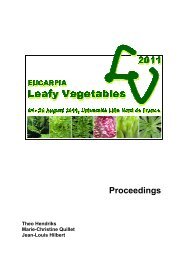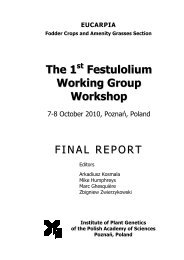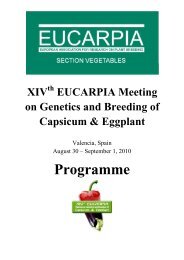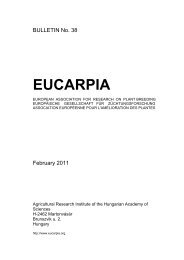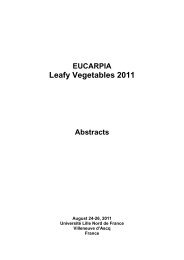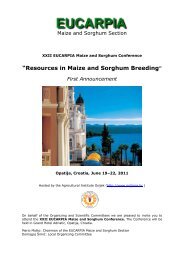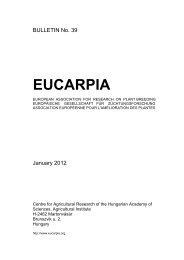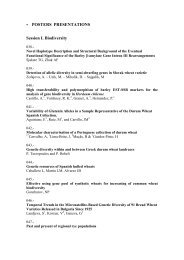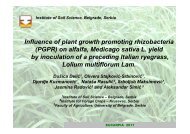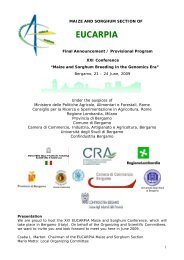Plant breeding for organic and sustainable, low-input agriculture
Plant breeding for organic and sustainable, low-input agriculture
Plant breeding for organic and sustainable, low-input agriculture
Create successful ePaper yourself
Turn your PDF publications into a flip-book with our unique Google optimized e-Paper software.
Potato cultivar Lady Balfour, an example of <strong>breeding</strong> <strong>for</strong> <strong>organic</strong> production<br />
John Bradshaw 1 , Paul Coleman 2 , Finlay Dale 1<br />
1 Scottish Crop Research Institute, Dundee, UK;<br />
2 GreenvaleAP, Doddington, UK<br />
Late blight (Phytophthora infestans) resistance is highly desirable in potato cultivars <strong>for</strong> <strong>organic</strong><br />
production. Without it, when blight appears, <strong>organic</strong> growers have to use copper-based<br />
fungicides or defoliation with a resultant loss of yield. Blight resistance has always been an<br />
important objective in the potato <strong>breeding</strong> programmes of the Scottish Crop Research Institute.<br />
When simply inherited major-genes failed to provide durable resistance, the breeders switched to<br />
selecting <strong>for</strong> high levels of field resistance. By 1991 some promising cultivars were available, in<br />
particular, cultivars Torridon, Brodick <strong>and</strong> Stirling. The effectiveness of their resistance <strong>and</strong> their<br />
yield advantage were demonstrated on <strong>organic</strong> farms (Wastie et al., 1992). However, commercial<br />
success was not achieved until 2001 when cultivar Lady Balfour [88P43(5)] was added to the<br />
UK National List. It has since become established as the leading <strong>organic</strong> potato in Great Britain.<br />
It was selected from a cross made in 1988 between clone 8204a(4) <strong>and</strong> clone 15119ac(5). Clone<br />
8204a(4) had good field resistance to late blight. Its pedigree traces back through eight<br />
generations to the few seed secured from a cross made in 1937 between diploid S. rybinii (= S.<br />
phureja) <strong>and</strong> hexaploid S. demissum, presumably the source of its blight resistance. Clone<br />
15119ac(5) had good quantitative resistance to both the golden <strong>and</strong> white potato cyst nematodes<br />
(Globodera rostochiensis <strong>and</strong> G. pallida). Its pedigree traces back through five generations to<br />
tetraploid S. vernei produced in 1958 by colchicine treatment of seed from a cross between two<br />
diploid accessions in the Commonwealth Potato Collection which had been screened <strong>and</strong> found<br />
resistant. Lady Balfour was selected to have resistance to both late blight <strong>and</strong> cyst nematodes.<br />
Organic ware trials in Engl<strong>and</strong> conducted by GreenvaleAP (three sites, 2001-2003) <strong>and</strong> NIAB<br />
(two sites, 2000-2006)(NIAB, 2007) demonstrated the high marketable yield <strong>and</strong> suitability of<br />
Lady Balfour <strong>for</strong> <strong>organic</strong> production. Furthermore, NIAB disease tests confirmed Lady Balfour’s<br />
high level of resistance to late blight <strong>and</strong> useful level of partial resistance to cyst nematodes.<br />
Conventional <strong>breeding</strong> <strong>for</strong> resistance to late blight <strong>and</strong> cyst nematodes produced a variety<br />
suitable <strong>for</strong> <strong>organic</strong> production. The chances of future success may be increased by selection in<br />
<strong>organic</strong> or <strong>low</strong> <strong>input</strong> environments, with increased emphasis on rapid establishment, good ground<br />
cover, early bulking yield potential <strong>and</strong> tolerance to drought stress through a better root system.<br />
52




